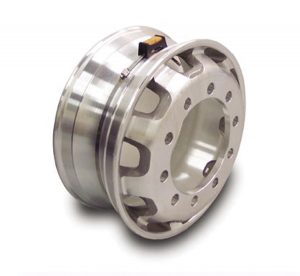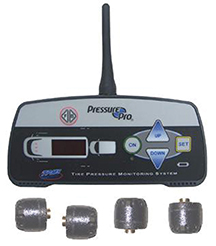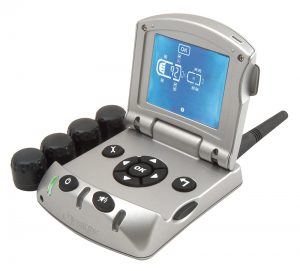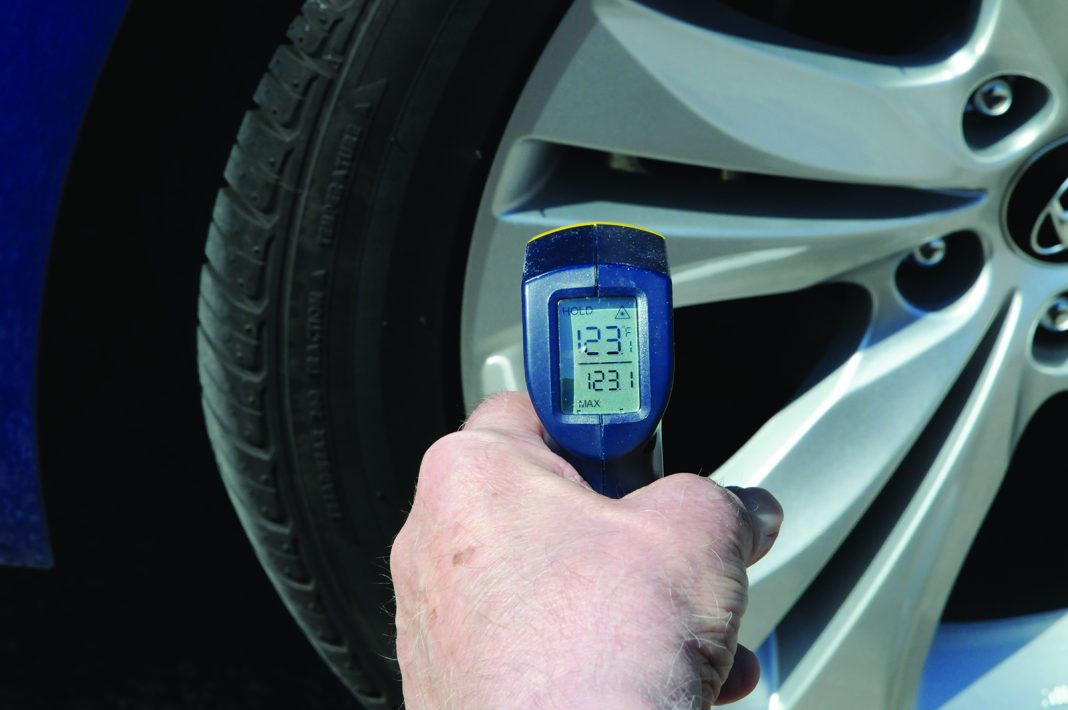By Garth W. Cane
Considering the price of top quality tires, one might expect that they would hold their inflation pressure for a very long time – but that’s not necessarily the case!
The rubber compounds that make up the modern tire are slightly porous – they will gradually lose pressure over time, whether you drive on them, or not.
Everyone should make a point of checking their tire inflation on a regular basis, and certainly before, during, and after a trip – it is a matter of safety, and the fringe benefits of regular tire checks include better handling, optimum fuel efficiency, and longer service life for the tires.
Under-inflation causes excess flexing of the sidewall of your tires and builds up heat that damages the inner liner, the casing, and the outer wall of the tire. Even a small degree of under-inflation can lower your fuel economy and shorten the tire life. On a motorhome, with tires inflated to 120 PSI, fuel efficiency drops by about one percent for every two pounds per square inch (psi) of under-inflation and shortens the life of your tires by 25%. On your tow vehicle or trailer, with tires inflated to 34 PSI, two PSI below the recommended inflation can have an even more dramatic effect. Motorists who measure and, if necessary, adjust their tire pressures monthly to the vehicle manufacturers recommendation can expect to save about two weeks worth of fuel annually, based on approximately 10,000 miles travelled per year.
Why is there such a variance between the efficiency of properly inflated tires and tires that are only a few PSI below the recommended pressure? A tire that is under-inflated does not roll as smoothly or as easily as it was intended to. This diminishes fuel efficiency because increased rolling resistance causes the vehicle to burn more fuel, which increases both fuel costs and emissions.
“Making sure your tires are always properly inflated is an easy way to achieve better fuel economy and lower harmful emissions,” says Glenn Maidment, President of the Rubber Association of Canada (RAC), which represents tire makers. On any given day on Canada’s roadways nearly 70 percent of vehicles have at least one tire that is over or under-inflated by at least 10 percent. More disturbingly, 23 percent have at least one tire under-inflated by more than 20 percent.
The cost of this neglect is considerable. According to research by Natural Resources Canada, Canadian drivers will burn an extra 643 million litres of the fuel and unwittingly release an additional one million tonnes of carbon dioxide into the air because one or more of their tires are under-inflated. Canadians can learn more about the fuel saving and environmental benefits of proper tire inflation and maintenance by visiting www.betiresmart.ca.
It is a fact that 9-out-of-10 tire failures are caused by driving on under-inflated tires. Tires do not become visibly low until they have lost 40% of their air. Simply “looking” at your tires just doesn’t work – by the time you see an obviously low tire it is much too late…dangerous driving conditions begin when the tire is 25% below the recommended inflation. Tire blowouts pose a serious risk to road users, especially if they happen while travelling at high speed. If a driver loses control of the vehicle, a lot of other people on the road are immediately endangered.
What causes loss of tire pressure? About 90 percent of all tire defects are attributable to a slow leak in tire pressure, this may be due to a small puncture caused by a screw, a nail, or a faulty valve. It may also be caused by the natural seepage of air right through the tire itself – that is why it is becoming commonplace for tire shops to inflate your tires using nitrogen, rather than straight air – even though the air we breathe is 78% nitrogen, the pure nitrogen molecule is larger than the pores in the rubber, dramatically reducing the tendency of the tire to lose pressure over time.
Tires do not normally blow out from wear but from under-inflation. Recently, a professional golfer had the right front tire of his RV blow out causing the death of two people when they ran into a tree at the side of the road.
The National Highway Transportation Safety Administration takes properly inflated tires seriously. In 2008, a mandate was put into place requiring all new passenger cars and light trucks to come equipped with a tire pressure monitoring system that will alert drivers of low tire pressure.
If you use Michelin XZE tires on your motorhome that are normally inflated to 90 pounds per square inch, each tire will lose 1250 pounds of carrying capacity if they are run at 75 psi. Since you have six tires on your motorhome, under-inflating your tires means that you lose a total of 7500 pounds of capacity to carry the load. The Michelin XZA3 tires used on the Triple E Empress coach featured in this issue of RV Lifestyle Magazine are inflated to 120 PSI, in keeping with the recommendations of the tire manufacturer, and the Freightliner chassis is engineered to be driven with tires inflated to this pressure.
Ask a tire expert whether you should ride on tires inflated to the recommendations stamped on the sidewall, or at the pressure stipulated on the vehicle manufacturer’s tire inflation notice, and the answer will be to follow the tire manufacturer’s guidelines… ask the vehicle manufacturer, and you may get a different answer – it all depends on the load range of the tire, and the actual weight of the vehicle.
The only way to safely know how much pressure should be in your tires is to have your RV weighed when it is loaded for travel. The RVSEF (Recreation Vehicle Safety and Education Foundation) offers a weighing service at many RV rallies in the USA and at a safety clinic to be held at the Hershey Pennsylvania RV Show in September.
To determine the loaded weight of your RV, you have to go to a weigh scale and drive over to find the weight on each wheel. You can find a weigh scale at truck stops, on the side of the highway, at gravel pits, and community dumpsites. Provincial scales on the side of the highway are free, but I would not go over the scale if there was a lineup of tractor-trailers waiting to be weighed. When we use the scales in truck stops, most have charged us $10 for the service. If you go through a state or provincial weigh scale facility, and your vehicle is over the maximum weight specified for the axles or the tires, you may have to make special arrangements to off-load a significant amount of weight… you may also be fined for operating an overloaded vehicle, and in extreme cases, your driver’s license classification may be questioned.
The first time I drive over a scale, I put just the front axle alone on the scale to find the total weight on that axle. Then I move ahead to place the rear axle on the scale.
The next time I go over a scale I move over to the left so that only the right front wheel is on the scale- if I deduct this reading from the total axle weight, I can now determine the weight on each front wheel. Now I drive ahead so that the right rear wheel is on the scale. Now deduct this reading from the total reading of the rear axle, and now you have a true weight on each wheel.
This is the time to go to the internet to download the tire inflation chart for your size and brand of tire. Charts are available free from www.michelin.com and www.goodyear.com. If you do not have access to a computer, then visit your favorite tire dealer and ask nicely to have him photocopy the inflation chart for your tires from his reference book. Now look at the chart to locate the correct number of pounds of air pressure that you need in each tire to support the weight on that wheel. Most of today’s RVs are heavier on one side than the other, so I always inflate both tires on the same axle to the amount of air required to support the heavier side.
I always check the inflation of each tire before a trip and then once each week during the trip. Some RV’ers check the inflation once each day, but I use an infra-red temperature gauge to check each tire every time I stop. If one tire is hotter than the others, then you probably have a problem with low inflation.
To make checking inflation easier without getting down on your hands and knees there are products available that allow you to see if a problem exists by looking at a monitor on the dash. Remote Inflation Monitors are installed on many new cars and will be mandatory on many new models in the near future. Now you can have the same convenience in your motorhome or your tow vehicle with an aftermarket monitoring system that will give you a warning when the pressure drops to a dangerous level. You will receive the first warning when the pressure in a tire drops by 10% and the next stage warning when it drops by 25%.

Systems like the SmarTire Monitor system are installed inside each wheel with the sensor mounted on the rim – this is done at the factory when the vehicle manufacturer is mounting the tire. Each sensor is a small transmitter that sends a signal to a nearby antenna mounted on the frame of the vehicle. To install the system after the RV or truck is built, the tires each have to be de-mounted so that the sensor can be installed on the rim, then the tire is re-inflated and the wheel is mounted on the chassis. A small antenna is mounted on the frame near each tire. The receiver is installed on the dash of the vehicle. The mounted wheel then needs to remain in that position on the vehicle. If you rotate your tires, you have to reprogram the system.

PressurePro alerts to low tire pressure – allowing time for corrective action during dangerous low tire pressure situations. PressurePro meets and exceeds the guidelines mandated by the TREAD Act, passed into law in 2002. PressurePro, employing Patented Technology, meets the needs of a huge market segment, providing increased safety and savings, all with a tire pressure monitoring system that is simple to install and easy to operate. PressurePro displays current tire pressure and alerts to dangerous low tire pressures, utilizing both a visual and audible alert. PressurePro employs “external sensor” technology, utilizing sensors which simply screw onto the valve stem, reading pressures from 10 to 150 psi on 1 to 34 wheel positions. PressurePro requires no tools to install, saving on professional installation charges. Tires can be rotated to a new position as long as the valve stem sensors stay at the same physical locations. The Pressure Pro is distributed in Canada by “You’ve Got Air”. The system is installed on many large vehicles with as many as 18 wheels that need to be checked.

The N-Vision Monitor System by Hopkins Manufacturing is one of the most flexible systems as it can monitor the inflation of the tires of your tow vehicle and trailer, and then after unhooking the trailer it still monitors the tires of your truck. It can monitor up to 24 tires simultaneously. It can be installed in minutes and is easily programmed to monitor tires with pressures from 10-150 psi.
The N-Vision TPMS has four memory positions that make it a perfect choice for anyone towing an RV, or a car behind a motorhome. Let’s consider a common example. Say you own a motorhome and tow a car when you travel. Program both the motorhome and car into memory position 1. As you drive, you’re tracking all of the tires on both vehicles. Then you reach a campground and want to sightsee for a few days. Just touch a button, switch to memory position 2 (which has just the car tires programmed). Instantly, the system stops looking for the motorhome tires. Transfer the monitor to the car and sightsee with the added security of tracking your car tires. Time to go to the next leg of your trip? No problem. Just touch a button, switch back to memory position 1 and the system instantly reacquires the sensors for both the car and the motorhome. It’s that easy.
Make sure your tires are inflated to the manufacturer’s recommended levels. The N-Vision TPMS will use the pressure in the tire at installation to create a “baseline” pressure level. The low or dangerously low pressure warnings will be triggered from this pressure level. Next, follow the monitor prompts to choose your pressure language (the system offers PSI, kPa and BAR, whichever you prefer). Follow the monitor prompts, tire by tire, and install the sensors. You will begin with the left front tire. When the pressure level reads correctly on the monitor, press “OK” to confirm. The prompt will advance to the next tire. Continue until you have completed all of the tires.
Should any tire fall 12.5% below normal, the yellow light will flash and a beeping alarm will sound. Simply open the monitor by touching the release button and the screen will flip open. The readouts for the low tire(s) will flash and display the exact tire pressure. If pressures fall to a dangerous level, a red light will flash and a constant tone will sound. The monitor is designed to operate in the closed position. By closing the screen, driver distractions are minimized. For example, when all of your tires are reporting normal tire pressures, the green light on the monitor face will be illuminated.
Properly inflated tires are safer, run cooler, last longer and maximize fuel economy. Tire Inflation monitors help you prevent damage from blowouts, help increase fuel economy, and can extend tire life by as much as 50%. Tire Inflation monitors continuously check tire pressures, even when your vehicle is not moving. Thanks to modern technology, there is no need to get out and check pressure by hand; the accurate pressures are displayed on the monitor right on your dashboard.
Looking for more information?
Talk to your RV dealer, or contact the following manufacturers:
N-Vision, Hopkins Manufacturing
“The Home of the Brake Buddy”
428 Peyton St, Emporia KS 66801-1157
800-470-2287 Fax 620-340-8590
www.hopkinsmfg.com
Smartire Systems, Inc
13151 Vanier Place, Ste 150, Richmond, BC V6V 2J1
888-982-3001 Fax 604-276-2350
www.smartire.com





















